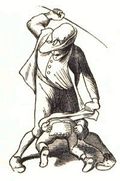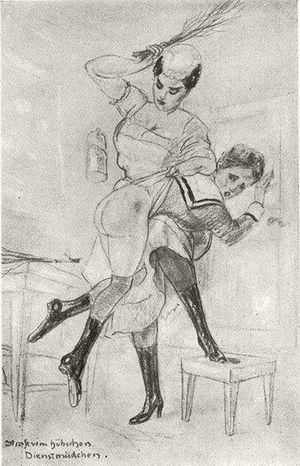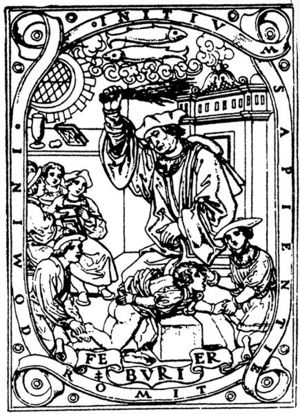Spanking in drawing
The drawing is the most popular medium for spanking art throughout history. Interestingly, when it comes to spanking art, painting has never taken over the leading role, as it happened with most other subject matters such as the nude or the still life. (However, unlike painting, photography was able to set foot in this genre to complement drawing.)
Practically all spanking drawings, irrespective of style and era, are drawings from imagination. Rare exceptions include drawings that were based on photo references (see creative tracing).
Spanking drawings in the Middle Ages and Renaissance
From the period of the middle ages, spanking drawings with pigmented ink are featured in religious and secular book illustrations. Soon the rise of first image printing technologies such as the woodcut and the engraving made it possible to reproduce black and white illustrations in many identical copies. There are a handful of spanking art prints from that era.
Later centuries brought advancement in perspective, as well further technical innovations such as the etching and the lithography, which allowed reproducing drawings in fine gradients of grey, from pitch-black to almost white. Employing these techniques, a skilled artist could create delicate figures that appeared very realistic and three-dimensional by making clever use of texture, hatching, light and shade. Most of these works were book illustrations. See spanking in illustration and historic spanking art for more information.
Spanking drawings in the 19th century

Around the mid-19th century, photography was invented. This artistic revolution meant that whenever a photorealistic likeness was desired, a photograph would do a better (and less time consuming) job than an artist's rendering. It was tempting to use photography for erotic art, and this new genre also produced spanking art pictures; see spanking in photography.
The invention of photography didn't wipe the art of drawing out, but had a logical impact on it: getting close to photorealism was no longer a challenge for most artists. Instead, artists turned to creating drawings that did what photography couldn't do. They dared into greater degrees of abstraction and exaggeration of features. This was the era when the art of the caricature and the cartoon flourished. Spanking art became funny. The first humorous spanking cartoons by artists such as Wilhelm Busch were drawn in that period. See spanking in cartoon for more on this.
Spanking drawings in 20th century

New photographic reproduction technologies allowed the reproduction in print of almost any artwork. This meant book and magazine illustrators could work again in ink, charcoal, or whatever medium they preferred.
At the beginning of the 20th century, the cartoon spawned an altogether new art form: the comic. Right from the beginning, spanking was a very popular theme in comics. In most comics series, child characters were the heroes, but it was felt important to show that they were just regular normal children who, like all childen of that time, were spanked for misbehavior (and sometimes unfairly) by their parents, uncles, aunts, teachers, or guardians. So this era produced a lot of comic child spanking art. The series that probably most famous (and loved) for its many funny spanking scenes was The Katzenjammer Kids, in which the two boy protagonists were spanked at least once in nearly every story. See spanking in comics for more on this.
A completely different genre of spanking art developed in the same period, one in which spanking was not portrayed as "funny" but erotic. Between 1900 and 1940, erotic spanking stories and novels became popular, especially in France (see early 20th century French spanking literature, and these were often accompanied by illustrations. The French artists Louis Malteste and Georges Topfer are among the most prolific and best known illustrators of that genre and era.
In World War II, the erotic novel business in Europe came to a halt. But in America of the 1940s, the comic spawned another new medium: cartoon animation. What had been spanking scenes in comics before, now entertained the audience in motion. See spanking in animation for more on this.
In Japan, the manga and anime developed slightly separate from the western comic and animation. The subject of spanking was not as common and popular in early mangas as it was in early comics. In later decades however, japanese artists would produce more spanking and BDSM related erotic hentai mangas and anime than their western colleagues. Part of this development may be due to the more restrictive anti-pornography laws in western countries. See spanking in manga and spanking in anime.
Spanking drawings in the computer age
The invention of the computer allowed artists to create and edit their artwork in digital form. Using a scanner, any drawing could be converted into an image file which could then be digitally edited, e.g. colorized, with an image editor before it was given to a publisher for printing.
In the 1990s, the Internet came, which meant a true revolution for spanking art fans worldwide. The greatest surprise for most was that there are so many of them. Almost immediately, Usenet newsgroups sprang up on the subjects of erotic spanking and spanking art, and websites were created to share spanking stories, drawings, photos, and video clips. New compressing image file formats such as GIF and JPEG made image files small enough to be transferred easily via protocols such as HTTP.
See also [ Adult spanking drawing ]
Chat rooms • What links here • Copyright info • Contact information • Category:Root
